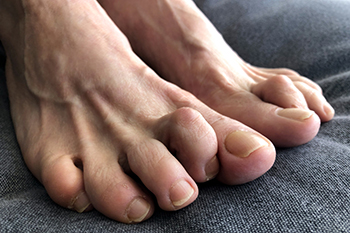Connect With Us
Blog
Items filtered by date: December 2022
Dealing With Hammertoe

Hammertoe is a deformity that is usually found in the second toe. It is caused by an imbalance of the muscles, tendons, and ligaments that work together to make the toe straight. The result is that the middle joint of the toe raises up to form a peak, while the tip of the toe curls under. The type of shoes you wear, foot structure, and genetics all can contribute to the formation of a hammertoe. Women who wear high heels with pointy toes and children who wear shoes that are too short for their feet are more at risk of developing a hammertoe. Some people are simply born that way. Pain from a hammertoe occurs when the raised joint rubs against the inside of the top of the shoe. A corn or callus can develop, which may affect the gait and can increase pain in other parts of the foot and the body. A podiatrist can give you options for treating a hammertoe. Devices called hammertoe regulators can be custom fitted to help straighten the toe. Gentle exercises, such as picking up a towel with your toes can stretch and straighten the small muscles of the feet. In severe cases, surgery can be performed to permanently straighten the toe. For details on treatment options, please consult a podiatrist.
Hammertoe
Hammertoes can be a painful condition to live with. For more information, contact Wendy L. Grossman, DPM from New Jersey. Our doctor will answer any of your foot- and ankle-related questions.
Hammertoe is a foot deformity that affects the joints of the second, third, fourth, or fifth toes of your feet. It is a painful foot condition in which these toes curl and arch up, which can often lead to pain when wearing footwear.
Symptoms
- Pain in the affected toes
- Development of corns or calluses due to friction
- Inflammation
- Redness
- Contracture of the toes
Causes
Genetics – People who are genetically predisposed to hammertoe are often more susceptible
Arthritis – Because arthritis affects the joints in your toes, further deformities stemming from arthritis can occur
Trauma – Direct trauma to the toes could potentially lead to hammertoe
Ill-fitting shoes – Undue pressure on the front of the toes from ill-fitting shoes can potentially lead to the development of hammertoe
Treatment
Orthotics – Custom made inserts can be used to help relieve pressure placed on the toes and therefore relieve some of the pain associated with it
Medications – Oral medications such as anti-inflammatories or NSAIDs could be used to treat the pain and inflammation hammertoes causes. Injections of corticosteroids are also sometimes used
Surgery – In more severe cases where the hammertoes have become more rigid, foot surgery is a potential option
If you have any questions please contact our office located in Bloomfield, NJ . We offer the newest diagnostic and treatment technologies for all your foot and ankle needs.
Joint Replacement for Arthritis of the Big Toe

The base of the big toe is a common site for degenerative changes in the foot. Wear and tear and loss of elasticity in the cartilage cushioning the joint of the big toe can cause pain, swelling, and stiffness in the area. With the big toe moving up each time a step is taken, walking can be uncomfortable. Bone spurs can develop on the joint aggravating the pain already felt when walking with big toe arthritis. A bump, like a bunion or a callus, can also develop on the top of the foot with this affliction. When rest, medication, and exercise stop working, surgical options are considered. One such option is toe joint replacement. This is usually done among older sufferers with advanced arthritis. With toe joint replacement, an artificial joint made from ceramic, plastic, or metal, is surgically implanted after removing damaged parts of bones and cartilage in the big toe. This can be done under general or regional anesthesia and usually takes less than one hour. If you have advanced arthritis in your big toe and other less invasive treatments have not provided you enough relief to live life comfortably, talk to a podiatrist to see if you might be a good candidate for joint replacement surgery.
In certain cases, in which the patient suffers from extreme pain or damage in a joint, joint replacement surgery may be deemed useful. If you have constant pain in a foot joint, consult with Wendy L. Grossman, DPM from New Jersey. Our doctor will assess your condition and provide you with quality foot and ankle treatment.
What Is Joint Replacement Surgery?
Over time, joints wear down; this can be exacerbated by diseases and conditions. Joint replacement surgery, also known as arthroplasty, is when a damaged joint is surgically removed and replaced with a prosthesis. Prostheses, which can be made of ceramic, plastic, or metal, act as joints in lieu of an actual joint. One of the most prevalent causes for joint replacement is arthritis.
Arthritis in the Foot
Arthritis can occur in any joint in the body, including in the feet. Common types of arthritis in the foot are osteoarthritis, rheumatoid arthritis, and gout. The big toe is usually where arthritis occurs in the foot; this is known as hallux rigidus.
Joint Replacement Surgery in the Foot
The most common form of joint replacement in the foot is a first metatarsophalangeal (MTP) joint placement. MTP joint replacement surgery is designed to treat hallux rigidus. Surgery is not intensive, and recovery occurs within one to two months after the procedure has been done. Overall, joint replacement surgery is a safe and effective way to treat pain in the joint of the foot.
If you have any questions, please feel free to contact our office located in Bloomfield, NJ . We offer the newest diagnostic and treatment technologies for all your foot care needs.
Blog Archives
- July 2025
- June 2025
- May 2025
- April 2025
- March 2025
- February 2025
- January 2025
- December 2024
- November 2024
- October 2024
- September 2024
- August 2024
- July 2024
- June 2024
- May 2024
- April 2024
- March 2024
- February 2024
- January 2024
- December 2023
- November 2023
- October 2023
- September 2023
- August 2023
- July 2023
- June 2023
- May 2023
- April 2023
- March 2023
- February 2023
- January 2023
- December 2022
- November 2022
- October 2022
- September 2022
